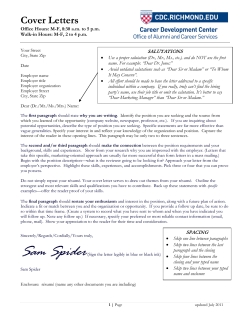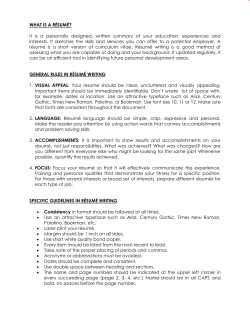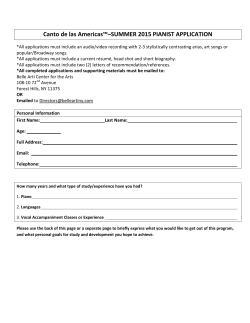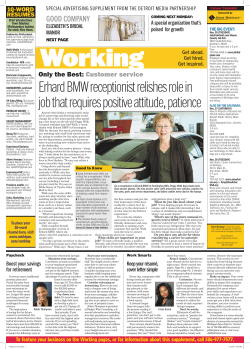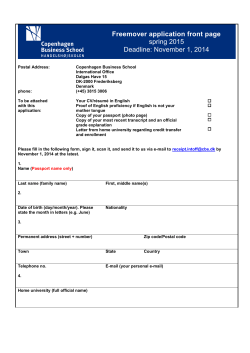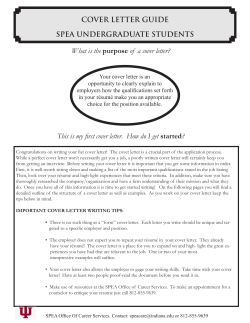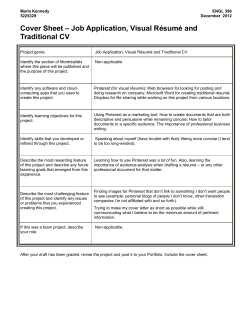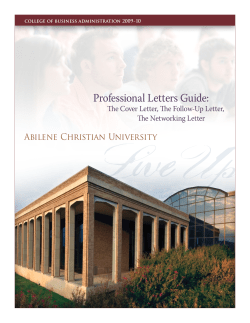
CCPD Resume and Cover Letter Writing Guide
RÉSUMÉ, CURRICUL LUM VITAE E (CV) & C COVER LE ETTER WRITING GUIDE 2 Guidelines for Résumé Writing 3 Key Words for Résumé Writing 4 Sample Résumé Format 5 Résumé VS. Curriculum Vitae (CV) 6 Your Résumé Checklist 7 Guidelines for Cover Letter Writing 9 Sample Cover Letter Format 10 Coverletter Worksheet 11 References Sample Format 12 Thank You & Follow-Up Sample Format 13 Résumé Examples14 Intermediate Résumé (Jr/Sr/Graduate) Example First-Year Students Junior, Senior (Upperclassman) Interior Design Digital Arts & Animation Graphic Design SILS Graduate Industrial Design Art Direction Architecture Historic Preservation Construction Management Critical Visual Studies Artist’s Résumé 3 GUIDELINES FOR RÉSUMÉ WRITING WHAT IS A RÉSUMÉ? The purpose of a résumé is to provide a summary of your skills, abilities and accomplishments related to the job you are seeking. It is a quick advertisement of who you are. It is a “snapshot” of you with the intent of capturing and emphasizing interests and secure you an interview. The good news for artists and designers who want to work in the creative industries is that there is not a “standard” résumé. It doesn’t have to be onesize-fits-all, but rather a chance to promote your individuality and style. However, there are some general guidelines that can help you create a more effective result. GENERAL TIPS 1. The résumé should be a one-page listing of your education, employment history and accomplishments. 2. Don’t over design. Keep it simple and organized. Use your design skills, but don’t gooverboard. Some résumés are so over-designed that they become difficult to read and no longer deliver the message. Consider various fonts and the use of bold and italicized text to make certain things stand out like job titles and company names. The bottom line is that your résumé needs to be competitive in overall appearance and content. 3. Make sure your résumé is letter-perfect. Misspellings and grammatical errors give a potential employer the wrong first impression. Have at least two people proofread your résumé. 4. Use parallel structure for all information–if you list a job title before place of employment in your first entry, do the same for the rest of your experience. 5. Use action verbs and omit personal pronouns (see page 4 for action verb ideas) (i.e. “implemented procedures” or “analyzed reports” rather than “I implemented procedures” or “I analyzed reports”). 6. Arrange your information in reverse chronological order; the most recent school attended and the most recent job you have held should be listed first. 7. Test your résumé for relevancy. The information included in your résumé should either support your job or internship goal directly or support your character as it relates to future opportunities. If you can’t define a definite purpose for including something, consider leaving it out. 8. Keep a separate list of references and make them available to potential employers only upon request. 9. Remember your résumé is only a door opener. Your goal is to be offered an interview. Do not assume your résumé will get you an interview with no additional effort on your part. You must follow up: - Use a powerful and compelling email cover letter - Network with your peers, past employers, department staff, and faculty 4 KEY WORDS FOR RÉSUMÉ WRITING A B C D E accelerated accomplished achieved adapted administered analyzed approved assessed assisted broadened budgeted built clarified collaborated compiled completed conceived conceptualized conducted consolidated contributed controlled created cultivated defined delegated demonstrated designed developed devised directed discovered effected eliminated enriched established estimated evaluated exceeded expanded expedited facilitated F G I L M O P found fulfilled gathered generated improved increased influential implemented initiated innovated instituted instructed interpreted pinpointed prepared presented proficient in programmed proposed proved provided R recommended reduced reinforced reorganized researched revamped reviewed revised S scheduled set up shaped simplified solved specialized streamlined strengthened structured summarized supervised supported surpassed launched lectured led maintained managed mastered monitored motivated operated organized originated participated performed planned T W taught trained translated utilized won wrote 5 TYPICAL RÉSUMÉ CONTENT ITEMS/SECTIONS CONTACT • his should include your name, address, phone T number, email, and website address • Be sure to print your name in a bold, large font size • our contact section can be a heading, located at Y the bottom, or to the left/the right on the page SKILLS • Include all computer, foreign language and technical skills. • Characterize your level of ability (proficient, knowledge of, experience in, familiar with, etc.) SUMMARY OF QUALIFICATIONS (optional) ACTIVITIES (optional) • Summarize • Include EDUCATION INTERESTS (optional) • List • This your most relevant skills and accomplishments in an action verb format. in reverse chronological order • Include institution, location, school division, degree, graduation date/expected graduation date • Majors • You and minors can include your GPA if it is above a 3.5. HONORS/AWARDS List any honors, scholarships or awards you have received, including any received from community or civic organizations. RELEVANT COURSEWORK (OPTIONAL) • List courses that are relevant to the position • Focus on electives and advanced courses EXPERIENCE • List job title, employer/organization, location (city and state only), dates of employment and a brief job description. Emphasize results and accomplishments! • Do not lead with “duties or responsibilities included” because this describes the job in more detail than it describes your abilities club memberships, community service and hobbies. Emphasize leadership duties. section adds a personal dimension to the résumé. Three interests are usually sufficient. 6 RÉSUMÉ VS. CURRICULUM VITAE (CV) One of the biggest differences between a résumé and a curriculum vitae (CV) is the audience it is intended to reach. •A CV that speaks largely to an academic audience and documents your academic and intellectual accomplishments. •A résumé is read by hiring managers and should be tailored to this group. Managers can often review hundreds of applicants for a single position. Your résumé must therefore be concise and clear enough to make an immediate impression. • Both must provide a persuasive account of your skills and experiences as they relate to the specific job. Most jobs in non-profits, government and the private sector in the United States will ask for a résumé. Faculty and teaching applications require a CV. • It is possible that high level positions will need a hybrid document that is a cross between a résumé and a CV. This is a shortened CV and can be about two to three pages and will provide a bit more information than the typical résumé (such as research experience, recent publications, etc.) but is still much shorter than a CV. The rule of thumb is that you can add 1 page per 10 years of experience. CV Résumé Audience Academics; applying for jobs abroad; applying for graduate school Goal To present your full academic history — including teaching, research, awards, publications, and service As long as necessary Demonstrating your academic achievements and scholarly potential Standard in US and Canada; general audience of employers who hire for a wide variety of positions To demonstrate that you have the skills and experience necessary to succeed within the position you are seeking Length Focus Essential Information References Lists of publications, presentations, teaching experiences, education, honors, and grants Include One or two pages only Representing your experiences — job related, extracurricular and volunteer, as well as the skills you’ve gained from these Skills and experiences you have gained as related to the job you are seeking Optional, not necessary 7 RÉSUMÉ CHECKLIST Ask yourself: Is it clear to the reader immediately what kind of job or internship you are qualified for? Are you sure it does not contain the pronoun “I” anywhere in the résumé? Are the jobs in your EXPERIENCE section and the schools in your EDUCATION section listed in reverse chronological order? Do you use a variety of action words and begin sentences with active verbs to make it more dynamic and interesting to read? Do you list accomplishments in the EXPERIENCE section? Many people simply list responsibilities or duties, but if you have the space, employers may want to know what you have accomplished. Do each of your experiences listed pass the “So What?” test. What was the outcome? What improved? Does it relate to the job you are applying for? Does it point to your future or anchor you to your past? Does the résumé reflect you as a person? Do you include special projects, job-relevant skills, volunteer activities or important things about you that an employer would find interesting and relevant? Is the format professional and attractive using a standard font and without spelling, punctuation or grammatical errors? It must be 100% correct! Is it concise and easy to read – and filled only with skills, experience or training relevant to the job you want? Have you shown it to a counselor or faculty member or your department staff for approval and comments? You should! Yes Needs More Work RÉSUMÉ, CURRICUL LUM VITAE E (CV) & C COVER LE ETTER WRITING GUIDE 9 GUIDELINES FOR COVER LETTER WRITING Anytime you email your résumé to a prospective employer, it needs to be accompanied by a full cover letter. LUM E CO ET The cover letter is a key document to introduce yourself, and a critical component in getting an interview. IT IS A LETTER OF INTRODUCTION The purpose of the cover letter is to introduce yourself to an employer. It gives you the opportunity to highlight your skills and experience in a way that clearly connects you to a particular position. IT IS A SALES LETTER •It is intended to convince the prospective employer that you have something valuable to contribute and that it will be worth the employer’s time to grant you an interview. The cover letter provides you with an excellent vehicle to highlight key credentials that match the major needs of the prospective employer. It should be 3 – 4 paragraphs: • Why you are writing and which job you are seeking • Your qualifications and why you feel you are a good candidate (provide concrete examples!) • What you know about the company, and the position or the industry • How you hope to continue the conversation When preparing a cover letter, keep these points in mind: 1. Type each cover letter individually, addressing it to a specific person and company. It is best to get a contact name and the title of the person to whom you are sending your letter. 2. Prioritize the most relevant information in each letter so you specifically connect your experience and interest to the company or person to whom you are writing. 3. Cover letters should be brief and to the point and include examples of your accomplishments. They should be no more than one page. 4. An effective way to end the letter is to state your plan for continuing the discussion (e.g. “I will call next week to discuss the possibility of setting up an interview”), or simply by thanking the employer for considering your application and listing a number where you can be reached to set up an interview. 5. Proofread carefully for spelling and grammatical errors. Always ask others to check for clarity, grammar, typos, and spelling. 10 SAMPLE COVER LETTER FORMAT Include a letterhead that matches your résumé if mailing or attaching: YOUR NAME ADDRESS, PHONE, EMAIL ADDRESS, WEBSITE Date Name of Person You’re Writing to Company Name Street Address City, State & Zip Re: or Position: __________________________________ Dear__________________________________: First Paragraph: If you’ve got a name to drop, someone who recommended you, use it in the opening. (“Steven Spielberg suggested...”). If you haven’t, then lead with the best cards you’ve got as they apply to the job at hand.(“I have 3 years experience at...” /“As a recent apprentice with...”) Can you tie in your virtues to something you know they need? (“I read that you just got the Maine Tourism account. As a native of Bangor, Maine,...”) State your points strongly but don’t sound presumptuous or conceited. Second Paragraph: Elaborate briefly. What specific experience, abilities or skills would apply to this job? If possible, back them with specific accomplishments. You might want to mention something not on your résumé that you think would be relevant or describe your approach as it relates to their culture. Be brief and to the point (remember, this is simply a supplement to your résumé). Third Paragraph: If you haven’t done it before, perhaps you’d want to mention something about them--the work you know they’ve done and how you admire it, and how/why you’d like to work for them specifically. The Closing: Keep it simple and fairly neutral. Never make assumptions. Thank them for considering your application. You may want to mention a web location where they can learn more about you or simply say you’d be happy to answer further questions. You can give them the best method to reach you and suggest that you get together to discuss your credentials further. Then end with: Sincerely, Your name 11 WORKSHEET COVER LETTER FIRST PARAGRAPH Why are you writing? What are the skills necessary for the position you are interested in? SECOND PARAGRAPH What can you offer the company (include information that extrapolates what you have on your résumé such as a particular approach or something of value that you brought to a previous professional experience that shows you are a great fit for what they need): What do you know about the company? THIRD PARAGRAPH Ask for an interview: 12 REFERENCES SAMPLE FORMAT • Send • Can to employers only when requested be included as a second page of your résumé if requested in the job posting • You must notify your references before giving their information out. When asking someone to be a reference for you, it is best to send them a copy of the job/internship description you have applied to or intend to apply to. YOUR NAME Address, Telephone Number, Email Address, Website Address REFERENCES 1. Name, Job Title Organization/Company Name Address Line 1 Address Line 2 Telephone Number Email Address 2. Name, Job Title Organization/Company Name Address Line 1 Address Line 2 Telephone Number Email Address 3. Name, Job Title Organization/Company Name Address Line 1 Address Line 2 Telephone Number Email Address 13 THANK YOU & FOLLOW-UP SAMPLE FORMAT Following an interview it is suggested you write to your contact expressing appreciation. If want to invest the time, you can stand out by designing and sending something more personal (a handmade card for example) in lieu of a formal letter or e-mail. WHY? • To show appreciation for their interest in you and cite the conversation you had with them. • To reiterate your interest in the position/ opportunity and in the organization. • To review or remind the employer about your qualifications for the position. If you thought of something you forgot to mention in the interview, mention it in your follow-up/thank-you letter. • To demonstrate that you have good manners which can be taken as a sign of professionalism. • To follow-up with any information the employer may have asked you to provide after the interview. You can also follow up after speaking with an employer at a career fair, panel discussion, roundtable event, lecture, or any other kind of networking or recruiting event. A letter/e-mail to follow up later is a good way to show initiative and continued interest. You can also simply thank the employer for her/his time in speaking with you; perhaps /he gave you advice you found helpful. • Thank-you letters can be hard copy, printed or handwritten, or e-mailed. • Handwritten letters are more personal, and can be appropriate for brief notes to a variety of individuals you may have met during an on-site interview. • E-mail is particularly appropriate as a supplement (i.e. do both e-mail and hard copy) when that has been your means of contact with the person you want to thank; if your contact has expressed a preference for e-mail; or you know your contact is travelling and will not have access to postal delivery in a timely fashion. RÉSUMÉ, CURRICUL LUM VITAE E (CV) & C COVER LE ETTER WRITING GUIDE LUM E CO ET 15 16 17 18 19 20 21 22 23 24 25 26 27 28 29 30 31 32 33
© Copyright 2025

